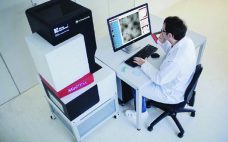Gene therapy is the transfer of genetic material to a patient’s cells to achieve a therapeutic effect. Therapeutic DNA typically is delivered using a viral vector system, and adenoviruses have been used for this purpose for over 20 years (1–3). Within the past 10 years or so, lentiviruses have shown promise in clinical trials (1–3), and adenoassociated viruses (AAVs) have been used in the first approved gene therapies in the Western world (4). The number of gene therapy applications based…
2017
Development of a Host-Cell Protein Platform Assay for a Chinese Hamster Ovary Cell Line
The Chinese hamster ovary (CHO) cell line is the most prevalent biopharmaceutical expression system and has been proven safe for commercial production of protein therapeutics (1). However, even after multiple purification steps, biopharmaceuticals contain residual host-cell protein (HCP) impurities that pose a potential safety risk to patients (2). Health authorities demand close monitoring of HCP impurities and require sensitive analytical methods with high coverage: the ability to detect a broad range of HCP impurities (3, 4). Polyclonal sandwich immunoassays are…
Moving DSC Downstream: Exploiting Differential Scanning Calorimetry As a Process Development Tool
The primary goal of biopharmaceutical process development is to determine what steps and conditions will maximize and optimize yields of purified product in the most reproducible, robust, and cost-efficient way. Characterized by high batch-to-batch comparability minimizing economic losses associated with batch failures, success relies on a thorough understanding of a given biological drug. Determining how its activity and stability are affected by processing and how to mitigate and control associated risks is advocated by a quality by design (QbD) approach.…
The 2017 World Biological Forum: Successes and Future Trends in Continuous Biomanufacturing
Continuous biomanufacturing was a central topic at the fourth annual World Biological Forum in Oxford, UK, on 26–28 June 2017. A well-rounded lineup of presenters appeared at this forum held in Oxford University’s Lady Margaret Hall, an eclectic location that well captured the historic charm of the university. Delegates were well supported throughout the meeting with generous meals, refreshments, and assistance provided by helpful staff. Papers were presented in Talbot Hall in the center of the college. The stately main…
Ask the Expert for Better Single-Use Powder Containment for Media and Buffers
Dave Howes (senior applications specialist at ILC Dover) introduces his company’s market-leading solution for single-use powder containment. Howes’s Presentation Some challenges in biopharmaceutical powder manufacturing include optimizing open-suite facilities; minimizing product loss from spills; lessening waste and cross-contamination; reducing worker exposure to airborne particulates; and lowering the risk of ignition with flammable materials. Characteristics to look for in a powder-transfer system are a system design that is exclusively meant for powders (not adapted from liquid-transfer designs) large-diameter top openings for…
Ask the Expert: Human-Error Reductions — Proper Task Performance in GMP Biomanufacturing
Tony Fultz (director of upstream manufacturing at Fujifilm Diosynth Biotechnologies) presented an “Ask the Expert” webinar on 23 August 2017. Fultz’s Presentation Human error was responsible for about 75% of batch failures at contract manufacturing organization Fujifilm Diosynth Biotechnologies in 2016. Technicians operate in a dynamic and stressful environment, both contributing factors to human error. With multiple projects running concurrently, some employees are involved in executing several processes during a shift. The company has several ways of reducing human error:…
Ask the Expert: CHT Column Packing Is Easier Than You Think
On 6 September 2017, Mark Snyder (manager of the process chromatography R&D applications group at Bio-Rad Laboratories) gave an “Ask the Expert” presentation on process-scale column packing with CHT ceramic hydroxyapatite media. Snyder’s Presentation CHT is an incompressible mixed-mode chromatography medium using cation exchange and calcium-affinity interactions, and it is available in 40-ÎĽm and 80-ÎĽm particle sizes. This medium can be used to purify monoclonal, polyclonal, and bispecific antibodies; antibody fragments; other recombinant proteins and isozymes; viruses, viral particles, and…
Achieving Consistent Performance by Managing Raw Material Variability Through Predictive Modeling
The past 30 years have brought significant progress in the design and manufacture of cell culture media as well as in the types of components used. With these advances, the biopharmaceutical industry improved its processes — from producing just a few milligrams of product per liter of culture to ≥10 g/L. Since the early days of microbiology, peptones have been used widely as a basic ingredient of microbial media. In the 1990s, peptones were introduced as a substitute for serum…
Collaborate to Innovate: Shaping the Future Pharmaceutical Manufacturing Landscape
As the demand for new life-enhancing therapies increases globally, the pharmaceutical manufacturing community faces an unprecedented challenge to accelerate speed to market. Keeping up to date on industry trends is critical to maintaining a competitive edge. But how do you actively drive these trends and apply them to your manufacturing processes to bring your innovation strategy to life? Whether you are implementing single-use technologies to reduce costs and increase productivity or expanding your operations in emerging markets, scientific collaboration and…
Introduction: Emerging Therapies Come of Age
According to a 2017 industry report, 74% of biopharmaceuticals currently in development (phase 1–3) are possible first-in-class medicines (those that use a unique mechanism of action), thus representing a potential new pharmacological class of treatment (1). They include regenerative medicines, conjugated monoclonal antibodies (MAbs), and DNA and RNA therapeutics. Some emerging therapies — such as antibody–drug conjugates (ADCs) and biobetters — have been more at the forefront of discussions than others, but all are poised to bring exciting changes to…








